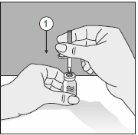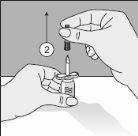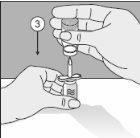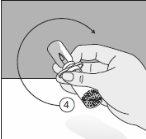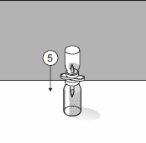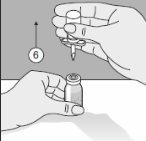
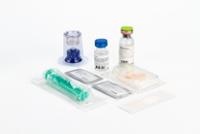
КІБЕРНІН П 500 МО Порошок і розчинник для приготування розчину для ін'єкцій або інфузій

Запитайте лікаря про рецепт на КІБЕРНІН П 500 МО Порошок і розчинник для приготування розчину для ін'єкцій або інфузій

Інструкція із застосування КІБЕРНІН П 500 МО Порошок і розчинник для приготування розчину для ін'єкцій або інфузій
Вступ
Опис: інформація для користувача
Kybernin P 500 UI порошок і розчинник для ін'єкційного та перфузійного розчину
Людська антитромбіна III
Прочитайте уважно весь опис перед початком використання цього лікарського засобу, оскільки він містить важливу інформацію для вас.
- Збережіть цей опис, оскільки вам може знадобитися знову його прочитати.
- Якщо у вас виникли питання, проконсультуйтеся з вашим лікарем або фармацевтом.
- Цей лікарський засіб призначений лише вам, і не слід давати його іншим людям, навіть якщо вони мають相同ні симптоми, оскільки це може їм нашкодити.
- Якщо ви відчуваєте побічні ефекти, проконсультуйтеся з вашим лікарем або фармацевтом, навіть якщо це побічні ефекти, які не вказані в цьому описі. Див. розділ 4.
Зміст опису
- Що таке Kybernin P і для чого він використовується
- Що вам потрібно знати перед початком використання Kybernin P
- Як використовувати Kybernin P
- Можливі побічні ефекти
- Збереження Kybernin P
- Зміст упаковки та додаткова інформація
1. Що таке Kybernin P і для чого він використовується
Kybernin P є порошком і розчинником для ін'єкційного та перфузійного розчину.
Цей лікарський засіб належить до групи лікарських засобів, званих антитромботичними агентами.
Kybernin P використовується, якщо у вас є вроджений дефект антитромбіну, для профілактики утворення та розвитку тромбів у кровоносних судинах ваших ніг (глибока венозна тромбоз) або в інших судинах вашого організму (тромбоемболізм) під час операції або в період після пологів та в поєднанні з гепарином, якщо це показано.
Kybernin P також використовується, якщо у вас є набутий дефект антитромбіну.
2. Що вам потрібно знати перед початком використання Kybernin P
Не використовувати Kybernin P:
Якщо ви алергічні на активну речовину або на будь-який інший компонент цього лікарського засобу (перелічені в розділі 6).
Попередження та обережність
Як і з будь-яким білковим продуктом для внутрішньовенної ін'єкції, можливі алергічні реакції. Потрібен тісний моніторинг та обережне спостереження за пацієнтами для виявлення будь-яких симптомів під час періоду інфузії. Пацієнтів потрібно проінформувати про перші ознаки алергічних реакцій, які включають шкірні висипи, які можуть призвести до загальної уртикарії, стиснення грудної клітки, труднощі з диханням, гіпотонію та анафілаксію. Якщо ці симптоми виникнуть після застосування, необхідно звернутися до лікаря.
У разі шоку слід дотримуватися чинних рекомендацій щодо лікування.
Вірусна безпека
При застосуванні лікарських засобів, отриманих з людської крові або плазми, необхідно проводити певні заходи для запобігання передачі інфекцій пацієнтам. Такі заходи включають:
- Обережний відбір донорів, щоб виключити тих, хто перебуває в групі ризику зараження інфекційними захворюваннями,
- Аналіз маркерів конкретних інфекцій у індивідуальних донорських матеріалах та у сумішах плазми,
- Включення етапів у процесі виробництва для видалення/інактивації вірусів.
Незважаючи на це, при застосуванні лікарських засобів, отриманих з людської крові або плазми, можливість передачі інфекційних агентів не можна повністю виключити. Це також стосується нових чи невідомих вірусів або інших типів інфекцій.
Захід, прийняті для запобігання передачі інфекцій, вважаються ефективними щодо вірусів з оболонкою, таких як ВІЛ, вірус гепатиту Б (ВГБ), вірус гепатиту С (ВГС), та щодо невірусних агентів, таких як вірус гепатиту А (ВГА) та парвовірус Б19.
Ваш лікар може порекомендувати вакцинацію проти гепатиту А та Б, якщо ви регулярно приймаєте продукти з антитромбіном, отриманим з плазми людини.
Високо рекомендується, щоб кожного разу, коли застосовується Kybernin P пацієнту, робили запис про назву лікарського засобу та номер партії, щоб підтримувати зв'язок між пацієнтом та партією продукту.
Клінічний та біологічний моніторинг у разі спільного застосування антитромбіну та гепарину:
- Для регулювання дози гепарину та уникнення надмірної гіпокоагуляції необхідно регулярно проводити контроль за ступенем антикоагуляції (АППТ, і коли це доречно активність анти-ФХа), на коротких інтервалах, особливо в перші хвилини/години після початку застосування антитромбіну.
- Визначення щоденного рівня антитромбіну для регулювання індивідуальної дози, через ризик зниження рівня антитромбіну внаслідок тривалого лікування гепарином.
Застосування Kybernin P з іншими лікарськими засобами
Гепарин: заміщення антитромбіну під час застосування гепарину в терапевтичних дозах збільшує ризик кровотечі. Ефект антитромбіну значно посилюється гепарином. Період напіввиведення антитромбіну може значно зменшитися через спільне лікування гепарином, через прискорену мобілізацію антитромбіну. Тому спільне застосування гепарину та антитромбіну пацієнту з високим ризиком кровотечі повинно бути обережно моніторовано клінічно та біологічно.
Повідомте вашого лікаря або фармацевта, якщо ви використовуєте, нещодавно використовували або можете використовувати інші лікарські засоби.
Вагітність, лактація та фертильність
Досвід щодо безпеки застосування продуктів антитромбіну людини під час вагітності обмежений.
Безпека застосування Kybernin P під час вагітності не встановлена в клінічних дослідженнях. Дослідження на тваринах недостатні для оцінки безпеки щодо репродукції, розвитку ембріона чи плода, перебігу вагітності та післяпологового розвитку.
Від'ємного досвіду щодо лікування під час вагітності та лактації немає.
Тому Kybernin P повинен застосовуватися вагітним або лактуючим жінкам з дефектом антитромбіну лише у випадках, коли це чітко показано, враховуючи той факт, що вагітність збільшує ризик тромбоемболічних епізодів у цих пацієнтів.
Якщо ви вагітні або перебуваєте в період лактації, вважаєте, що можете бути вагітною або плануєте вагітність, проконсультуйтеся з вашим лікарем або фармацевтом перед застосуванням цього лікарського засобу. Ваш лікар зважить можливий ризик для плода та інформуватиме вас, чи є лікування цим лікарським засобом доречним. Ваш лікар рекомендуватиме це лікування лише у випадках, коли це чітко показано.
Водіння транспортних засобів та використання машин
Немає жодних ознак того, що Kybernin P може впливати на здатність керувати транспортними засобами або використовувати машини.
Kybernin P 500 UI містить натрій
Пацієнти з дієтою з низьким вмістом натрію повинні враховувати, що Kybernin P 500 UI містить до 44,76 мг (1,947 ммоль) натрію на 500 ОД.
3. Як використовувати Kybernin P
Kybernin P є лікарським засобом для використання в лікарнях, тому його буде застосовувати в лікарні медичний персонал.
Kybernin P застосовується шляхом підготовки розчину, який потім вводиться або перфундувується внутрішньовенно повільно (максимально 4 мл/хв).
Слідуйте точно інструкціям щодо застосування цього лікарського засобу, вказаним вашим лікарем або фармацевтом. У разі сумнівів проконсультуйтеся знову з вашим лікарем або фармацевтом.
Ваш лікар призначить, з якою частотою та на які інтервали повинен застосовуватися Kybernin P.
Ваш лікар призначить тривалість лікування Kybernin P.
Якщо ви застосували більше Kybernin P, ніж потрібно:
Не повідомлялося про симптоми передозування антитромбіном.
У разі передозування або випадкового застосування зверніться до Токсикологічної служби. Телефон 91 562 04 20.
Якщо ви забули застосувати Kybernin P:
- Негайно проконсультуйтеся з вашим лікарем або фармацевтом.
- Не застосовуйте подвійну дозу для компенсації пропущених доз.
4. Можливі побічні ефекти
Як і всі лікарські засоби, цей лікарський засіб може спричиняти побічні ефекти, хоча не всі люди їх відчувають.
Наступні побічні реакції базуються на досвіді після реєстрації. У випадках, коли доступні дані, використовувалися наступні стандартні категорії частоти:
Дуже часто >1/10
Часто >1/100 до <1>
Нечасто ≥ 1/1 000 до <1>
Рідко ≥ 1/10 000 до <1>
Дуже рідко <1>
Класифікація за органами та системами | Вибраний термін | Частота |
Розлади імунної системи | Алергічна реакція/анafilактичні реакції, включаючи важку анафілаксію та шок. | Рідко |
Загальні розлади та в місці застосування | Пірексія | Рідко |
Для інформації про вірусну безпеку див. «Попередження та обережність» у розділі 2 цього опису.
Повідомлення про побічні ефекти
Якщо ви відчуваєте будь-які побічні ефекти, проконсультуйтеся з вашим лікарем або фармацевтом, навіть якщо це побічні ефекти, які не вказані в цьому описі. Ви також можете повідомити про них безпосередньо через Іспанську систему фармакологічного моніторингу лікарських засобів для людини: https://www.notificaram.es. Повідомляючи про побічні ефекти, ви можете допомогти надати більше інформації про безпеку цього лікарського засобу.
5. Збереження Kybernin P
Тримайте цей лікарський засіб поза зоною видимості та досягнення дітей.
Не зберігають при температурі вище 25 ºС. Не заморожуйте.
Не застосовуйте цей лікарський засіб після закінчення терміну придатності, вказаного на упаковці після EXP. Термін придатності - останній день місяця, який вказано.
Не застосовуйте розчини, які є мутними або містять осад (відкладення/частинки).
Після реконституції фізико-хімічна стабільність була доведена протягом 8 годин при кімнатній температурі (макс. 25 ºС). З мікробіологічної точки зору та оскільки Kybernin P не містить консервантів, реконституйований розчин повинен бути застосований негайно. Якщо це не можливе, не зберігайте більше 8 годин при кімнатній температурі (максимально 25 ºС).
Видалення незастосованого лікарського засобу або матеріалу для утилізації повинно здійснюватися згідно з місцевими правилами.
Лікарські засоби не повинні викидатися у водопровідні труби чи сміття. Спитайте вашого фармацевта, як позбутися упаковок та лікарських засобів, які вам більше не потрібні. Таким чином, ви допоможете захистити навколишнє середовище.
6. Зміст упаковки та додаткова інформація
Склад Кібернін П 500 МО
- Активний інгредієнт - антитромбін III. Кожна ліофілізована ампула містить 500 МО антитромбіну III. Реконституована розчин містить приблизно 50 МО антитромбіну III/мл антитромбіну, отриманого з людської плазми, коли його реконститують з 10 мл води для ін'єкцій.
Потужність (МО) визначається за допомогою методу хромогенічного субстрату згідно з Європейською фармакопеєю. Специфічна активність Кіберніну П становить приблизно 5,3 МО/мг білка.
- Інші компоненти: гліцин, хлорид натрію, цитрат натрію, хлоридна кислота або гідроксид натрію (для регулювання pH) та вода для ін'єкцій.
Див. розділ 2 для отримання важливої інформації про деякі допоміжні речовини.
Вигляд продукту та вміст упаковки
Порошок і розчинник для ін'єкційної розчини та для перфузії.
Упаковка для продажу містить скляну ампулу типу II (за
Фарм. Євр.), безбарвну та запечатану гумовим корком, пластиковим диском і алюмінієвою капсулою
, яка містить ліофілізований продукт, ампулу з 10 мл води для ін'єкцій (розчинник
для підготовки розчину) та трансфузор.
Варіанти упаковки:
Індивідуальна упаковка Кібернін П 500 МО:
1 ампула ліофілізованого продукту
1 ампула з 10 мл води для ін'єкцій
1 трансфузор
Клінічна упаковка Кібернін П 500 МО:
10 ампул ліофілізованого продукту
10 ампул з 10 мл води для ін'єкцій
10 трансфузорів
Можливо, що тільки деякі розміри упаковок будуть продаватися.
Власник дозволу на продаж та відповідальна особа за виробництво
Власник дозволу на продаж
CSL Behring, S.A.
вул. Таррагона, 157, 18-й поверх
08014 Барселона - Іспанія
Відповідальна особа за виробництво
CSL Behring GmbH
вул. Еміля фон Беринга, 76
35041 Марбург - Німеччина
Дата останнього перегляду цього посібника:листопад 2020 р.
Детальна та актуальна інформація про цей лікарський засіб доступна на сайті Іспанського агентства з лікарських засобів і медичних продуктів (AEMPS) http://www.aemps.gob.es
Ця інформація призначена лише для медичних працівників:
Дозування
При спадковому дефіциті доза повинна бути індивідуалізована для кожного пацієнта, враховуючи сімейну історію щодо тромбоемболічних епізодів, клінічні фактори ризику пацієнта та лабораторні тести.
Дозування та тривалість терапії заміни при набутому дефіциті залежать від рівня антитромбіну плазми, наявності ознак підвищеної мобілізації, основного захворювання та тяжкості клінічної картини пацієнта. Дозу та частоту введення повинні завжди базуватися на клінічній ефективності та лабораторних тестах у кожному окремому випадку.
Кількість одиниць антитромбіну, що вводяться, виражається в Міжнародних одиницях (МО), у відношенні до стандарту Всесвітньої організації охорони здоров'я (ВООЗ) для антитромбіну. Активність антитромбіну плазми виражається як відсоток (у відношенні до нормальної людської плазми) або в Міжнародних одиницях (у відношенні до міжнародного стандарту для антитромбіну в плазмі).
Одна міжнародна одиниця (МО) активності антитромбіну еквівалентна кількості антитромбіну в 1 мл людської нормальної плазми. Розрахунок необхідної дози антитромбіну базується на емпіричному знахідці, що 1 Міжнародна одиниця (МО) антитромбіну на кілограм маси тіла підвищує активність антитромбіну плазми приблизно на 1,5%.
Початкова доза визначається за допомогою наступної формули:
Потрібні одиниці = маса тіла [кг] х (100 – поточна активність антитромбіну [%]) х 2/3.
Активність антитромбіну, яку потрібно досягти спочатку, залежить від клінічного стану. Коли встановлено, що заміна антитромбіном показана, доза повинна бути достатньою для досягнення бажаної активності антитромбіну та для підтримання ефективного рівня. Дозу повинні визначати та контролювати згідно з лабораторними тестами на активність антитромбіну, які проводяться至少 двічі на день до стабілізації пацієнта, а потім один раз на день, переважно безпосередньо перед наступною перфузією. Корекція дози повинна враховувати як ознаки підвищеної продукції антитромбіну згідно з лабораторними тестами, так і клінічну еволюцію. Активність антитромбіну повинна підтримуватися вище 80% під час лікування, якщо клінічний стан не вказує на інший рівень ефективності.
Типова початкова доза при спадковому дефіциті становить 30-50 МО/кг.
Отже, дозу та частоту введення, а також тривалість лікування повинні коригуватися згідно з біологічними даними та клінічною ситуацією.
Педіатричне населення:
Кібернін П не рекомендується для використання у дітей молодших 6 років через нестачу даних.
На основі клінічного досвіду не можна рекомендувати використання антитромбіну в лікуванні СДРІ (Синдром дистресу респіраторного у дітей) у недоношених дітей.
Інструкції для правильного введення препарату
Загальні інструкції
Ліофілізований порошок повинен бути повністю реконституований під асептичними умовами з супроводжуючим розчинником. Отримується прозора або легенько опалесцентна розчин.
Підходящим розчинником є розчин альбуміну людини 5%. Для підготовки розбавлень з титруванням до 1:5 можна використовувати також: рінгер-лактатний розчин, фізіологічний розчин, розчин глюкози 5% або полігеліну.
Використання гідроксієтилованих крохмалів не рекомендується як розчинник (для перфузії), оскільки спостерігається втата активності антитромбіну.
Цей лікарський засіб не повинен змішуватися з іншими лікарськими засобами в шприці/обладнанні для перфузії. Допамін, добутамін і фуросемід не повинні вводитися через той же венозний доступ.
Продукт повинен вводитися внутрішньовенно. Максимальна швидкість перфузії: 4 мл/хв.
Реконституція
Для правильного використання Transofix з подвійною голкою слід виконувати наступні кроки:
|
|
|
|
|
|
|
|
|
|
|
|
- Країна реєстрації
- Діючі речовини
- Потрібен рецептТак
- Виробник
- Інформація є довідковою і не є медичною порадою. Перед прийомом будь-яких препаратів обов'язково проконсультуйтеся з лікарем. Oladoctor не несе відповідальності за медичні рішення, прийняті на основі цього контенту.
- Альтернативи до КІБЕРНІН П 500 МО Порошок і розчинник для приготування розчину для ін'єкцій або інфузійФорма випуску: РОЗЧИН ДЛЯ ІНФУЗІЙ, ЩО ВВОДИТЬСЯ ІН'ЄКЦІЙНО, 1000 ОД антитромбін III людиниДіючі речовини: antithrombin IIIВиробник: Octapharma S.A.Потрібен рецептФорма випуску: РОЗЧИН ДЛЯ ІНФУЗІЙ, ЩО ВВОДИТЬСЯ ІН'ЄКЦІЙНО, 500 ОД антитромбін III людиниДіючі речовини: antithrombin IIIВиробник: Octapharma S.A.Потрібен рецептФорма випуску: РОЗЧИН ДЛЯ ІН'ЄКЦІЙ, 1000 ОД антитромбінуДіючі речовини: antithrombin IIIВиробник: Csl Behring S.A.Потрібен рецепт
Аналоги КІБЕРНІН П 500 МО Порошок і розчинник для приготування розчину для ін'єкцій або інфузій в інших країнах
Найкращі аналоги з тією самою діючою речовиною та терапевтичним ефектом.
Аналог КІБЕРНІН П 500 МО Порошок і розчинник для приготування розчину для ін'єкцій або інфузій у Польща
Аналог КІБЕРНІН П 500 МО Порошок і розчинник для приготування розчину для ін'єкцій або інфузій у Україна
Лікарі онлайн щодо КІБЕРНІН П 500 МО Порошок і розчинник для приготування розчину для ін'єкцій або інфузій
Консультація щодо дозування, побічних ефектів, взаємодій, протипоказань та поновлення рецепта на КІБЕРНІН П 500 МО Порошок і розчинник для приготування розчину для ін'єкцій або інфузій – за рішенням лікаря та згідно з місцевими правилами.




